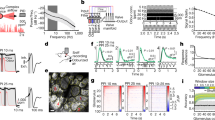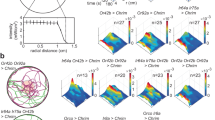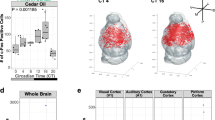Abstract
Olfactory systems encode odours by which neurons respond and by when they respond1,2,3. In mammals, every sniff evokes a precise, odour-specific sequence of activity across olfactory neurons4,5,6. Likewise, in a variety of neural systems, ranging from sensory periphery7,8 to cognitive centres9, neuronal activity is timed relative to sampling behaviour and/or internally generated oscillations. As in these neural systems, relative timing of activity may represent information in the olfactory system10,11. However, there is no evidence that mammalian olfactory systems read such cues12,13. To test whether mice perceive the timing of olfactory activation relative to the sniff cycle (‘sniff phase’), we used optogenetics in gene-targeted mice to generate spatially constant, temporally controllable olfactory input. Here we show that mice can behaviourally report the sniff phase of optogenetically driven activation of olfactory sensory neurons. Furthermore, mice can discriminate between light-evoked inputs that are shifted in the sniff cycle by as little as 10 milliseconds, which is similar to the temporal precision of olfactory bulb odour responses14,15. Electrophysiological recordings in the olfactory bulb of awake mice show that individual cells encode the timing of photoactivation in relation to the sniff in both the timing and the amplitude of their responses. Our work provides evidence that the mammalian olfactory system can read temporal patterns, and suggests that timing of activity relative to sampling behaviour is a potent cue that may enable accurate olfactory percepts to form quickly11,16.
This is a preview of subscription content, access via your institution
Access options
Subscribe to this journal
Receive 51 print issues and online access
$199.00 per year
only $3.90 per issue
Buy this article
- Purchase on Springer Link
- Instant access to full article PDF
Prices may be subject to local taxes which are calculated during checkout



Similar content being viewed by others
References
Laurent, G. Olfactory network dynamics and the coding of multidimensional signals. Nature Rev. Neurosci. 3, 884–895 (2002)
Friedrich, R. W. & Laurent, G. Dynamic optimization of odor representations by slow temporal patterning of mitral cell activity. Science 291, 889–894 (2001)
Junek, S., Kludt, E., Wolf, F. & Schild, D. Olfactory coding with patterns of response latencies. Neuron 67, 872–884 (2011)
Macrides, F. & Chorover, S. L. Olfactory bulb units: activity correlated with inhalation cycles and odor quality. Science 175, 84–87 (1972)
Chaput, M. & Holley, A. Single unit responses of olfactory bulb neurones to odour presentation in awake rabbits. J. Physiol. (Paris) 76, 551–558 (1980)
Spors, H., Wachowiak, M., Cohen, L. B. & Friedrich, R. W. Temporal dynamics and latency patterns of receptor neuron input to the olfactory bulb. J. Neurosci. 26, 1247–1259 (2006)
Szabo, T. & Hagiwara, S. A latency-change mechanism involved in sensory coding of electric fish (mormyrids). Physiol. Behav. 2, 331–335 (1967)
Gollisch, T. & Meister, M. Rapid neural coding in the retina with relative spike latencies. Science 319, 1108–1111 (2008)
O'Keefe, J. & Recce, M. L. Phase relationship between hippocampal place units and the EEG theta rhythm. Hippocampus 3, 317–330 (1993)
Hopfield, J. J. Pattern recognition computation using action potential timing for stimulus representation. Nature 376, 33–36 (1995)
Schaefer, A. T. & Margrie, T. W. Spatiotemporal representations in the olfactory system. Trends Neurosci. 30, 92–100 (2007)
Monod, B., Mouly, A. M., Vigouroux, M. & Holley, A. An investigation of some temporal aspects of olfactory coding with the model of multi-site electrical stimulation of the olfactory bulb in the rat. Behav . Brain Res. 33, 51–63 (1989)
Leon, M. & Johnson, B. A. Is there a spacetime continuum in olfaction? Cell. Mol. Life Sci. 66, 2135–2150 (2009)
Cury, K. M. & Uchida, N. Robust odor coding via inhalation-coupled transient activity in the mammalian olfactory bulb. Neuron 68, 570–585 (2010)
Shusterman, R., Smear, M., Koulakov, A. & Rinberg, D. Precise olfactory responses tile the sniff cycle. Nature Neurosci. 14, 1039–1044 (2011)
Margrie, T. W. & Schaefer, A. T. Theta oscillation coupled spike latencies yield computational vigour in a mammalian sensory system. J. Physiol. (Lond.) 546, 363–374 (2003)
Boyden, E. S., Zhang, F., Bamberg, E., Nagel, G. & Deisseroth, K. Millisecond-timescale, genetically targeted optical control of neural activity. Nature Neurosci. 8, 1263–1268 (2005)
Raman, B., Joseph, J., Tang, J. & Stopfer, M. Temporally diverse firing patterns in olfactory receptor neurons underlie spatiotemporal neural codes for odors. J. Neurosci. 30, 1994–2006 (2010)
Nagel, K. I. & Wilson, R. I. Biophysical mechanisms underlying olfactory receptor neuron dynamics. Nature Neurosci. 14, 208–216 (2011)
Cang, J. & Isaacson, J. S. In vivo whole-cell recording of odor-evoked synaptic transmission in the rat olfactory bulb. J. Neurosci. 23, 4108–4116 (2003)
Perkel, D. H. & Bullock, T. H. Neural coding. Neurosci. Res. Prog. Bull. 6, 219–349 (1968)
Brody, C. D. & Hopfield, J. J. Simple networks for spike-timing-based computation, with application to olfactory processing. Neuron 37, 843–852 (2003)
Hall, C., Bell, C. & Zelick, R. Behavioral evidence of a latency code for stimulus intensity in mormyrid electric fish. J. Comp. Physiol. A 177, 29–39 (1995)
Di Lorenzo, P. M., Leshchinskiy, S., Moroney, D. N. & Ozdoba, J. M. Making time count: functional evidence for temporal coding of taste sensation. Behav. Neurosci. 123, 14–25 (2009)
Jacobs, A. L., Fridman, G., Douglas, R. M., Alam, N. M. & Latham, P. Ruling out and ruling in neural codes. Proc. Natl Acad. Sci. USA 106, 5936–5941 (2009)
VanRullen, R., Guyonneau, R. & Thorpe, S. J. Spike times make sense. Trends Neurosci. 28, 1–4 (2005)
Curtis, J. C. & Kleinfeld, D. Phase-to-rate transformations encode touch in cortical neurons of a scanning sensorimotor system. Nature Neurosci. 12, 492–501 (2009)
Montemurro, M. A., Rasch, M. J., Murayama, Y., Logothetis, N. K. & Panzeri, S. Phase-of-firing coding of natural visual stimuli in primary visual cortex. Curr. Biol. 18, 375–380 (2008)
Grosmaitre, X., Santarelli, L. C., Tan, J., Luo, M. & Ma, M. Dual functions of mammalian olfactory sensory neurons as odor detectors and mechanical sensors. Nature Neurosci. 10, 348–354 (2007)
Bozza, T., McGann, J. P., Mombaerts, P. & Wachowiak, M. In vivo imaging of neuronal activity by targeted expression of a genetically encoded probe in the mouse. Neuron 42, 9–21 (2004)
Bunting, M., Bernstein, K. E., Greer, J. M., Capecchi, M. R. & Thomas, K. R. Targeting genes for self-excision in the germ line. Genes Dev. 13, 1524–1528 (1999)
Rinberg, D., Koulakov, A. & Gelperin, A. Sparse odor coding in awake behaving mice. J. Neurosci. 26, 8857–8865 (2006)
Garthwaite, P. H., Jolliffe, I. T. & Jones, B. Statistical Inference (Oxford Univ. Press, 2002)
Acknowledgements
We thank L. Doglio and the Transgenic and Targeted Mutagenesis Laboratory at Northwestern University for generation of chimaeric mice, B. Weiland for technical help with cloning and gene targeting, D. Huber, D. O'Connor and T. Komiyama for advice on mouse behaviour, D. Wesson and M. Wachowiak for instruction on sniff measurement, J. Nunez-Iglesias for assistance with statistics, G. Shtengel for advice on laser set-up, and T. Tabachnik and H. Davidowitz for help designing the behavioural rig. J. Osborne fabricated the microdrive. G. Lott provided digital acquisition software. A. Koulakov contributed to spike-sorting and classification algorithms. We thank W. Denk, K. Svoboda, R. Gütig, R. Egnor, M. Orger and A. Resulaj for comments on the manuscript. This work was supported by the Visiting Scientist Program at JFRC. T.B. was supported by NIDCD (R01DC009640, R21DC010911), the Whitehall Foundation and the Brain Research Foundation.
Author information
Authors and Affiliations
Contributions
M.S. and D.R. designed the study and build the experimental set-up, M.S. performed the experiments and analysed the behavioural data. R.S. and M.S. performed the electrophysiological recordings, R.S. and D.R. analysed the electrophysiological data, and T.B. initiated the transgenic approach and generated the gene-targeted mice. R.O. developed the laser optics and optical fibre design. M.S., T.B. and D.R wrote the manuscript. D.R. and T.B. supervised the project.
Corresponding authors
Ethics declarations
Competing interests
The authors declare no competing financial interests.
Supplementary information
Supplementary Figures
The file contains Supplementary Figures 1-4 with legends. (PDF 1118 kb)
Rights and permissions
About this article
Cite this article
Smear, M., Shusterman, R., O’Connor, R. et al. Perception of sniff phase in mouse olfaction. Nature 479, 397–400 (2011). https://doi.org/10.1038/nature10521
Received:
Accepted:
Published:
Issue Date:
DOI: https://doi.org/10.1038/nature10521
This article is cited by
-
Robust encoding of natural stimuli by neuronal response sequences in monkey visual cortex
Nature Communications (2023)
-
Long-range GABAergic projections contribute to cortical feedback control of sensory processing
Nature Communications (2022)
-
Active sensing in a dynamic olfactory world
Journal of Computational Neuroscience (2022)
-
Fast odour dynamics are encoded in the olfactory system and guide behaviour
Nature (2021)
-
Spatial information from the odour environment in mammalian olfaction
Cell and Tissue Research (2021)
Comments
By submitting a comment you agree to abide by our Terms and Community Guidelines. If you find something abusive or that does not comply with our terms or guidelines please flag it as inappropriate.



